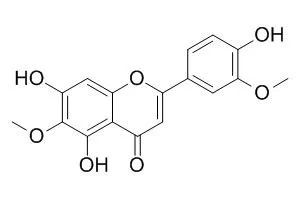| Kinase Assay: |
| Exp Biol Med (Maywood). 2014 Oct;239(10):1325-34. | | Jaceosidin, a natural flavone, promotes angiogenesis via activation of VEGFR2/FAK/PI3K/AKT/NF-κB signaling pathways in endothelial cells.[Pubmed: 24939823 ] | Angiogenesis, the growth of new blood vessels from pre-existing vasculature, plays an important role in physiological and pathological processes such as embryonic development wound healing and revascularization of tissues after exposure to ischemia.
METHODS AND RESULTS:
We investigated the effects of Jaceosidin, a main constituent of medicinal herbs of the genus Artemisia, on angiogenesis and signaling pathways in endothelial cells. Jaceosidin stimulated proliferation, migration and tubulogenesis of ECs as well as ex vivo sprouting from aorta rings, which are phenomena typical of angiogenesis. Jaceosidin activated vascular endothelial growth factor receptor 2 (VEGFR2, FLk-1/KDR) and angiogenic signaling molecules such as focal adhesion kinase, phosphatidylinositol 3-kinase, and its downstream target, the serine-threonine kinase AKTWe also demonstrated that Jaceosidin activated the NF-κB-driven expression of a luciferase reporter gene and NF-κB binding to DNA. Jaceosidin-induced proliferation and migration of human umbilical vascular endothelial cells were strongly inhibited by the phosphatidylinositol 3-kinase inhibitor LY294002 and NF-κB inhibitor BAY11-7082, indicating that the PI3K/AKT/NF-κB signaling pathway is involved in Jaceosidin-induced angiogenesis.
CONCLUSIONS:
Our results suggest that Jaceosidin stimulates angiogenesis by activating the VEGFR2/FAK/PI3K/AKT/NF-κB signaling pathway and that it may be useful in developing angiogenic agents to promote the growth of collateral blood vessels in ischemic tissues. | | Arch Pharm Res. 2010 Dec;33(12):1985-96. | | In vitro metabolism of jaceosidin and characterization of cytochrome P450 and UDP-glucuronosyltransferase enzymes in human liver microsomes.[Pubmed: 21191764] | Jaceosidin is an active component in Artemisia species as well as Eupatorium species and it exhibits antiallergic, anticancer, antioxidant, anti-inflammatory, and antimutagenic activities. Jaceosidin was metabolized to Jaceosidin glucuronide, 6-O-desmethylJaceosidin, hydroxyJaceosidin, 6-O-desmethylJaceosidin glucuronide, and hydroxyJaceosidin glucuronide in human liver microsomes.
METHODS AND RESULTS:
This study characterized the human liver cytochrome P450 (CYP) and UDPglucuronosyltransferase (UGT) enzymes responsible for the metabolism of Jaceosidin. CYP1A2 was identified as the major enzyme responsible for the formation of 6-O-desmethylJaceosidin and hydroxyJaceosidin from Jaceosidin on the basis of a combination of correlation analysis and experiments including immuno-inhibition, chemical inhibition in human liver microsomes, and metabolism by human cDNA-expressed CYP enzymes. Jaceosidin glucuronidation was catalyzed by UGT1A1, UGT1A3, UGT1A7, UGT1A8, UGT1A9, and UGT1A10.
CONCLUSIONS:
These results suggest that the pharmacokinetics of Jaceosidin may be dramatically affected by polymorphic CYP1A2, UGT1A1, and UGT1A7 responsible for the metabolism of Jaceosidin or by the coadministration of relevant CYP1A2 or UGT inhibitors or inducers. |
|






 Cell. 2018 Jan 11;172(1-2):249-261.e12. doi: 10.1016/j.cell.2017.12.019.IF=36.216(2019)
Cell. 2018 Jan 11;172(1-2):249-261.e12. doi: 10.1016/j.cell.2017.12.019.IF=36.216(2019) Cell Metab. 2020 Mar 3;31(3):534-548.e5. doi: 10.1016/j.cmet.2020.01.002.IF=22.415(2019)
Cell Metab. 2020 Mar 3;31(3):534-548.e5. doi: 10.1016/j.cmet.2020.01.002.IF=22.415(2019) Mol Cell. 2017 Nov 16;68(4):673-685.e6. doi: 10.1016/j.molcel.2017.10.022.IF=14.548(2019)
Mol Cell. 2017 Nov 16;68(4):673-685.e6. doi: 10.1016/j.molcel.2017.10.022.IF=14.548(2019)